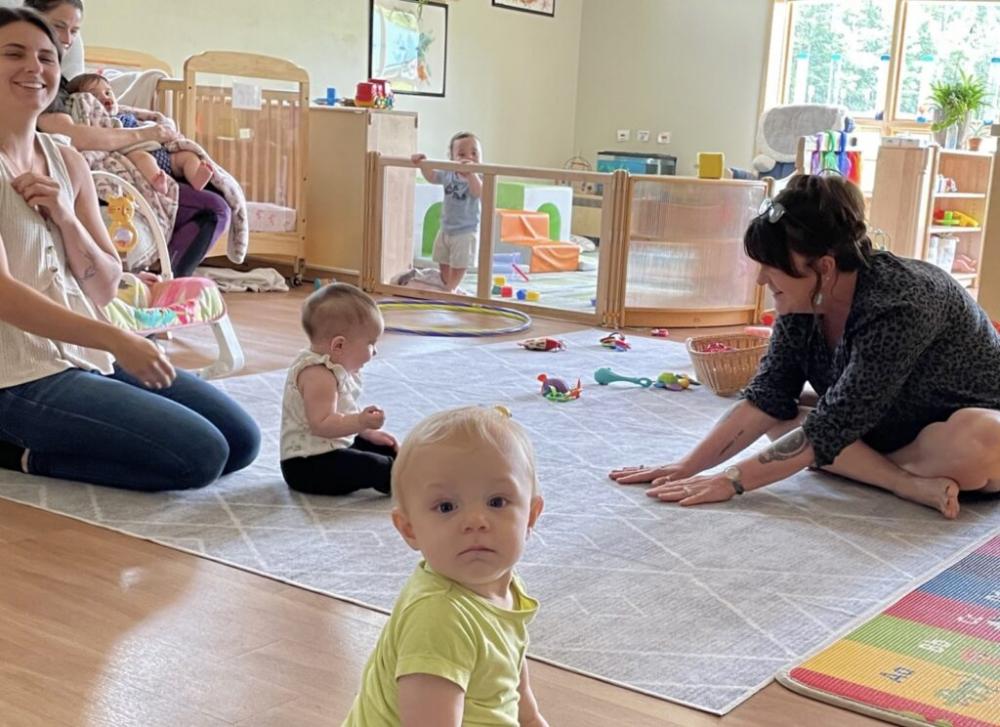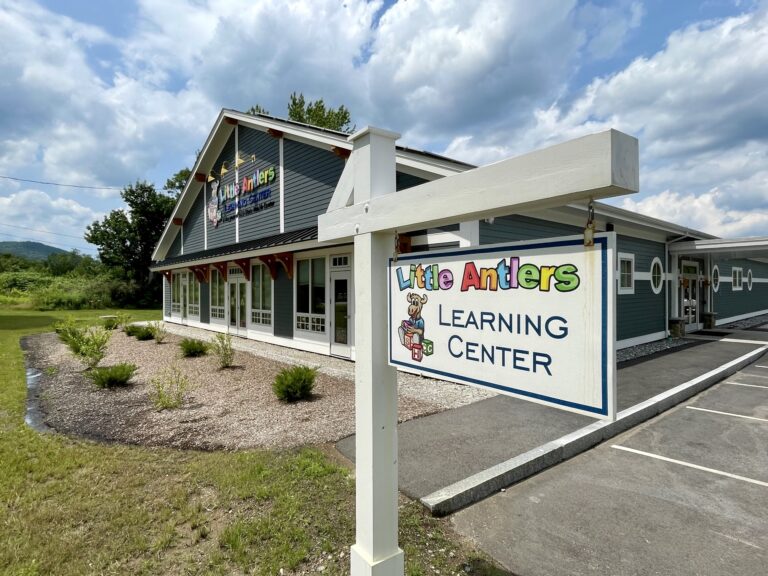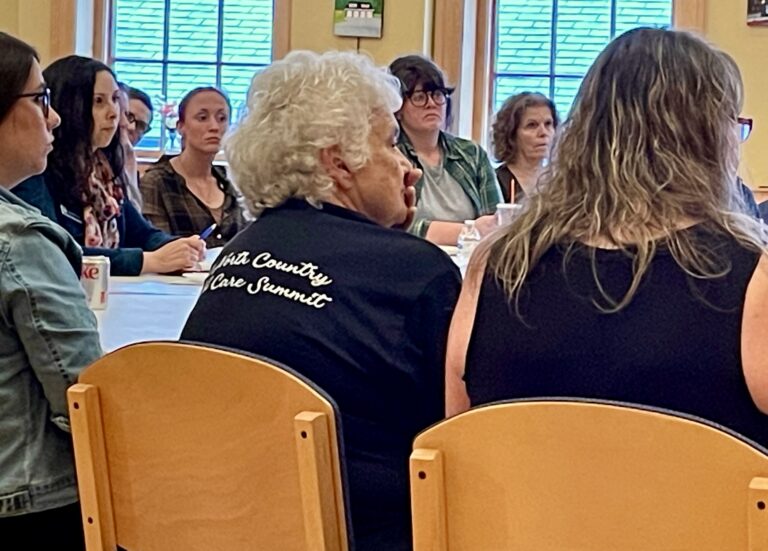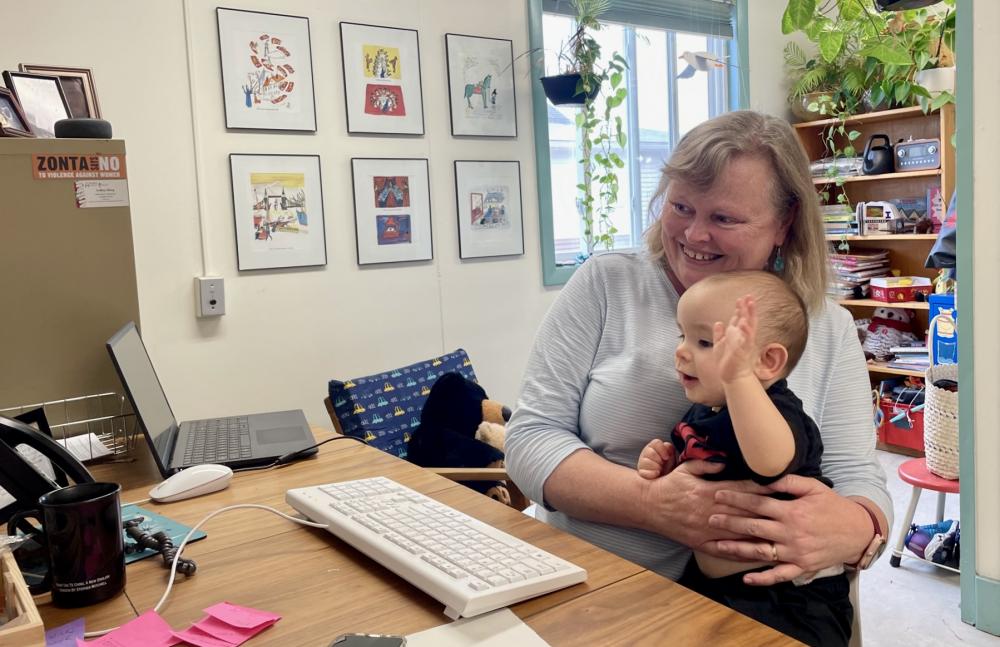 Teachers Madi Dalphonse and Kree Woolley work with infants at the Little Antlers Learning Center in Plymouth. (Annmarie Timmins | New Hampshire Bulletin)
Teachers Madi Dalphonse and Kree Woolley work with infants at the Little Antlers Learning Center in Plymouth. (Annmarie Timmins | New Hampshire Bulletin)
Little Antlers Learning Center in Plymouth gets calls daily from parents desperate for a spot, like many child care providers. It’s also hearing from organizations interested in recreating its model.
That’s not a surprise.
Unlike many providers, Little Antlers Learning Center can give its teachers health benefits and half-price tuition for their children, with a goal of making it free. Fifty-one percent of its approximately 60 spots are reserved for low-to-moderate-income families. It’s open 10 hours a day to accommodate parents’ schedules, and it takes infants and kids up to age 6. There’s an internship program in the works. Parents can get tuition assistance in an emergency.
Here’s how Little Antlers does it: It’s part of the Mid-State Health Center in Plymouth, which launched the center in 2007 for employees as a recruiting tool. Now it’s open to the community and funded by the health center as well as tax credits and grants.
The health center has recently launched a fundraising campaign to raise $1 million to increase tuition assistance.
“After we did a feasibility study, we saw the need for our community,” said Director Alison Murphy. “I always knew it was there, but we wanted to get some hard data to show it was feasible.”

Little Antlers Learning Center in Plymouth is able to offer teachers benefits because it is part of the Mid-State Health Center. (Annmarie Timmins | New Hampshire Bulletin)
The state of New Hampshire has invested an unprecedented amount in the last three years to expand the number of child care spots, including more than $100 million in one-time federal pandemic aid.
Most of that federal money has been spent. And while the state budget signed in June contains $15 million for worker recruitment and retention, and money to expand tuition assistance for families, it won’t be enough to eliminate waitlists that can run 200 names long, child care leaders say.
More money will be part of the solution, they said, but not the only part. Providers, lawmakers, and economic development leaders are looking elsewhere for ideas.
One lawmaker wants to expand the number of slots by slightly increasing the number of children each child care worker can oversee. The Mt. Washington Valley Chamber of Commerce is beginning to put child care front and center in its conversations with members, calling it “foundational” to their and the region’s success. There’s talk of reviving a statewide high school program to create a pipeline of new workers.
The Monadnock Economic Development Corporation in Keene is launching a program focused on expanding child care in people’s’ homes, which it sees as ideal for rural towns, with grants and tax credits. It hopes to add 60 to 120 spots by giving people financial assistance to make required health and safety improvements to their homes and get business and child care training.

Cody Morrison is the executive director of the Monadnock Economic Development Corporation (Courtesy)
“Instead of just sitting around the table and making the same pitch and saying the same thing over and over again, ‘We need this, we need that,’ we’re doing something about it because we don’t have a choice,” said Executive Director Cody Morrison.
It’s the kind of creative partnership that Executive Councilor Joe Kenney of Wakefield is advocating for as he travels his northern district, talking to child care providers and especially employers. Public-private partnerships and new ideas are necessary, he said.
“If we can solve child care in New Hampshire, we’re going to live in one hell of a great state,” Kenney said. “If you can crack the code of child care, everything else will take care of itself.”
Significant change, significant disruption
Although the child care shortage is getting more attention than ever, families and providers say the shortage is long-standing.
In 2020, the state’s 33,000 licensed child care spots for children under 6 met only 60 percent of the need, according to a study commissioned by the state Department of Health and Human Services.
That gap grew during the pandemic, as workers became harder to find, often because they could earn more money elsewhere – the average wage is about $12 an hour – or couldn’t find care for their own children.
“You can get a job at Walmart making $20 an hour,” said Murphy, of Little Antlers. Being able to offer benefits and discounted tuition is crucial to her recruitment, she said. “In the current economy, of course they are going to take those jobs,” she said. “It may not make them happy, but it will pay their bills.”
As child care centers continue to close, other centers see their waitlists grow.

Jane LeBlanc attends a child care listening session in Gorham earlier this month. (Annmarie Timmins | New Hampshire Bulletin)
Jane LeBlanc shuttered Kids Only Day Care in Berlin in February, after running it for 33 years, because two workers left for other jobs. Two staff members, of four, took other jobs, one in another field for higher pay, leaving about 45 children with no care. A second center did the same six weeks later.
“I’m going to be 70,” said LeBlanc, who had planned to retire and close in June but hadn’t yet said so. “It’s so hard to find people, and I can’t start over. I hated it for the families.”
What happened next shows the fragility of the existing child care system.
As soon as LeBlanc closed, the phones lit up at the Gorham Community Learning Center six miles away.
“The calls we got were constant,” said Mariah Middleton, coordinator of the infant and toddler program, during a recent child care discussion in Gorham. Families were told they could be added to the already long waitlist. “It was heartbreaking,” Middleton said.
Maine and Vermont are addressing their shortages with a significant increase in state spending. Vermont lawmakers overrode a governor’s veto in June to spend $120 million annually on child care. Maine recently doubled its state-funded stipends for child care workers from $200 to $400 a month.
Providers like LeBlanc said centers will continue to lose workers to higher pay, further strapping the system, if the state doesn’t give them more money. The millions of federal dollars they got during the pandemic helped boost wages by $2 to $3, enough to get workers up to $18 or $19 an hour.
Raising tuition is not an option, providers said. The average cost of infant care is $14,425 per year, according to the health advocacy organization New Futures, slightly less than the average cost of a public university education in New Hampshire, according to the study done for the Department of Health and Human Services.
“Families can pay only so much,” LeBlanc said. “I think there definitely needs to be more government intervention if we want to keep these places going.”
It’s near certain some lawmakers will push for more state funding beyond the $15 million in this year’s budget for worker recruitment, that’s not the approach favored by Rep. Ross Berry, a Manchester Republican who chairs a new special legislative committee focused on child care, however.

Rep. Ross Berry, a Manchester Republican, is chairman of a new special legislative committee focused on child care. (Courtesy)
Berry, who owns a child care center in Epsom, wants tweaks like a ratio change that will allow a child care worker to oversee five infants, instead of four. Do the math, he said, and that can quickly add a number of spots to existing centers without more money.
He wants the state to make it easier for child care workers to meet their continuing education requirements, too. He also supports the high school child care program.
“I see more money as a Band-Aid. Substantive change is going to require significant disruption in the process,” Berry said. “You can put a new radio into a Ford Pinto, but it is still a Ford Pinto. I personally believe we are at the point where we need to get a new car.”
A model for rural towns
The Monadnock Economic Development Corporation’s effort to increase home-based child care began with a conversation Keene Mayor George Hansel hosted between state and local leaders, funding agencies, and community organizations, including the Cheshire Children’s Museum.
The Bringing It Home Project launched this year with $1 million in federal funding and $500,000 in tax credits from the Community Development Finance Authority. Morrison, the organization’s executive director, said they’ve begun meeting with five families interested in providing in-home care and hope to launch by the end of the year, with a goal of adding 60 to 120 new child care spots.
“Our interest in getting involved in this initiative was because child care is a top-three economic development issue in the state,” said Morrison, who has been with the group for a year. “The other two being housing and workforce.”
A grant from the New Hampshire Charitable Foundation will pay for a consultant to help people through the child care licensing process. The money raised through selling tax credits will go toward home renovations a potential provider must make to meet health and safety codes, such as fencing a yard or knocking down a wall to expand the size of a gathering area.
The Monadnock United Way and Keene State College received funding to expand training and employment pipelines for early childhood education. Morrison said this effort wouldn’t have succeeded without the partnerships between such diverse groups, from the children’s museum to federal funders and business leaders.
“A big advantage to this is that the commercial (child care) inventory may not be there in a lot of rural towns,” Morrison said. “If you take a small town like Marlow or Gilsum, they might not have the downtown, commercial real estate inventory for someone to be able to go and start a child care center.”
But they still have workers – and employers – who need child care, he said.
“This allows for more rural communities to be able to have the adequate level of child care capacity that their urban counterparts might. We’re anticipating this being a model that other communities, other parts of the state are going to be looking at,” said Morrison.
‘How do we move forward?’
New Hampshire received nearly $142 million in federal pandemic assistance specifically for child care. The initial funding was aimed at emergency needs and then stabilization: giving child care providers assistance to remain open and families help to pay for child care. Nearly $108 million in pandemic assistance went to providers directly.

Marianne Barter is the executive director at Merrimack Valley Day Care in Concord. (Annmarie Timmins | New Hampshire Bulletin)
Merrimack Valley Day Care, a Concord nonprofit that’s offered child care for more than 50 years, wouldn’t have survived the pandemic without that assistance and other federal aid like the Paycheck Protection Program, said Executive Director Marianne Barter.
“I mean, we took advantage of absolutely everything we possibly could,” Barter said. “Anything that came our way we applied for, and we have spent every single cent of it. Absolutely every cent. And a large part of that has been going towards keeping child care affordable for families and to our teachers to make sure that they understood that what they were doing is vital.”
That money is gone, leaving Barter with no choice but to increase tuition by almost 20 percent, she said, for the first time in two years.
“We had a board meeting about this … and my board understood and we decided to move forward with it,” Barter said “But I don’t think there was a dry eye in the room.”
The state is exploring new ideas for shoring up the state’s fragile child care system and making it more affordable. To that end, lawmakers included $45.5 million to expand eligibility for state child care assistance and increase payments to providers. The state is also adjusting how it pays providers so they don’t lose money for days a child is absent.
But Karen Hebert, director of the Division of Economic Stability at the Department of Health and Human Services, knows it will take far more than that.
She said the state will invest the remaining $29 million in federal money in long-term sustainable solutions. The department spent six months asking providers and parents looking for child care to identify their greatest needs, she said.
Those conversations informed the department’s long-term sustainability plan, which splits the remaining dollars across four priorities: strengthening the workforce and the overall system, helping families afford child care, and improving the quality of child care.
“It isn’t just about giving providers money. It’s about how do we move forward?” Hebert said. “Because there are no plans as far as I know from the federal government to provide any further funding. How do we use this money wisely to be able to continue child care and continue building it, and rebuilding and strengthening it in New Hampshire?”
Barter, who’s worked for Merrimack Valley Day Care for more than 20 years and been its director for six, said she’s thrilled lawmakers agreed to invest $15 million for providers to recruit and retain workers. “It’s amazing,” she said, but if every child care provider took advantage of the funding, raises wouldn’t get to $1 an hour.
For every child care worker you hire, Barter said, you can enroll eight children. “So the ripple effect of a hire is huge because now all of a sudden many parents get to go work,” she said. “So each hire is enormously important.”
And each loss is equally so.
This story is courtesy of NH Bulletin under creative commons license. No changes have been made to the article.

 Current Issue - May 2024
Current Issue - May 2024